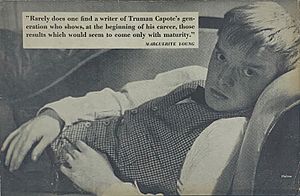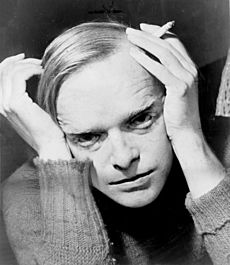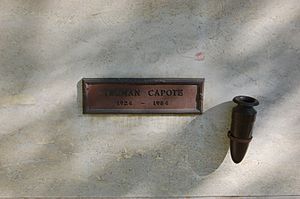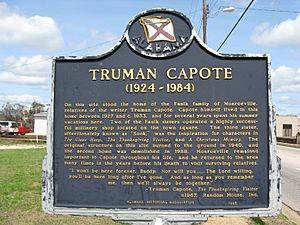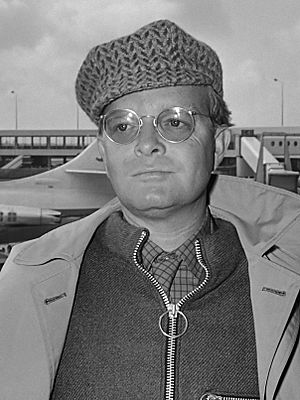Truman Capote facts for kids
Quick facts for kids
Truman Capote
|
|
|---|---|
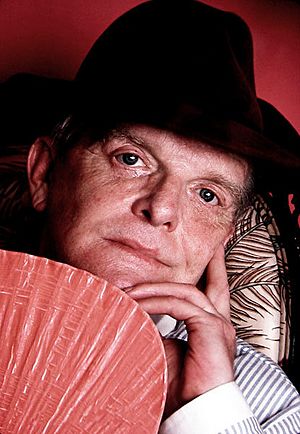
Capote in 1980 by Jack Mitchell
|
|
| Born |
Truman Streckfus Persons
September 30, 1924 New Orleans, Louisiana, U.S.
|
| Died | August 25, 1984 (aged 59) Los Angeles, California, U.S.
|
| Resting place | Westwood Village Memorial Park Cemetery |
| Other names | Truman Garcia Capote |
| Education | Greenwich High School Dwight School |
| Occupation |
|
| Years active | 1942–1984 |
| Movement |
|
| Partner(s) | Jack Dunphy (1948–1984; his death) |
| Signature | |
Truman Garcia Capote (born Truman Streckfus Persons; September 30, 1924 – August 25, 1984) was an American writer. He wrote novels, screenplays, and plays. Many of his stories and books are considered classics. These include the short novel Breakfast at Tiffany's (1958) and the true crime book In Cold Blood (1966). He called In Cold Blood a "non-fiction novel." More than 20 films and TV shows have been made from his works.
Capote had a difficult childhood. He moved around a lot and was away from his mother for a long time. But he found his love for writing when he was only eight years old. He worked hard to improve his writing skills as he grew up. He started his career by writing short stories. His story "Miriam" (1945) was very successful. This led to a contract with a publisher to write his first novel, Other Voices, Other Rooms (1948). Capote became most famous for In Cold Blood (1966). He spent six years writing this book. His good friend, Harper Lee, who wrote To Kill a Mockingbird (1960), helped him.
Contents
Truman Capote's Early Life
Truman Capote was born in New Orleans, Louisiana. His parents were Lillie Mae Faulk and Archulus Persons. They divorced when he was two years old. He was sent to Monroeville, Alabama, to live with his mother's relatives. He stayed there for about four or five years. He became very close to his distant relative, Nanny Rumbley Faulk, whom he called "Sook." Capote described Sook as having a "craggy" face, like Abraham Lincoln's.
In Monroeville, Capote lived next door to and became friends with Harper Lee. She also became a famous writer and remained his friend for life. Many people believe that the character of Dill in Lee's book To Kill A Mockingbird is based on Capote.
Becoming a Writer
Capote was a lonely child. He taught himself to read and write before starting school. When he was five, he often carried a dictionary and a notepad. He started writing stories when he was 11. Around this time, people nicknamed him "Bulldog."
On Saturdays, he would travel from Monroeville to Mobile. He once sent a short story called "Old Mrs. Busybody" to a children's writing contest. It was held by the Mobile Press Register. Capote also received an award for his early writing in 1936.
In 1932, he moved to New York City. He lived with his mother and her second husband, José García Capote. José adopted Truman, and Truman changed his name to Truman García Capote.
Capote said about his early days, "I was writing seriously when I was about 11. Like other kids practiced music, I would go home from school every day and write for about three hours. I was obsessed by it." He went to the Trinity School in New York. Then he attended St. Joseph Military Academy. In 1939, his family moved to Greenwich, Connecticut. Truman went to Greenwich High School. He wrote for the school's literary journal and newspaper. In 1941, they returned to New York City. He attended the Franklin School, now called the Dwight School, and finished in 1942. This was the end of his formal schooling.
While still at Franklin in 1942, Capote worked as a copyboy at The New Yorker magazine. He worked there for two years before being fired. He later said, "It wasn't a grand job, but I was lucky to have it. I never wanted to go to college. I felt you were either a writer or you weren't, and professors couldn't change that." He left his job to live with relatives in Alabama. There, he started writing his first novel, Summer Crossing.
He was called to join the army during World War II. But he was turned down because he was found to be "too neurotic."
Friendship with Harper Lee
Capote based the character of Idabel in Other Voices, Other Rooms on his best friend, Harper Lee. He once said, "Harper Lee's parents lived very near. She was my best friend. Did you ever read her book, To Kill a Mockingbird? I'm a character in that book. It takes place in the same small town where we lived. Her father was a lawyer, and we used to go to trials all the time as children." After Lee won the Pulitzer Prize in 1961 and Capote published In Cold Blood in 1966, their friendship became less close.
Truman Capote's Writing Career
Short Stories and Early Books
Capote started writing short stories when he was about 8 years old. In 2013, 14 of his unpublished stories from his teenage years were found. They were published in 2015 as The Early Stories of Truman Capote.
Between 1943 and 1946, Capote wrote many short stories. These included "Miriam," "My Side of the Matter," and "Shut a Final Door." He won an O. Henry Award for "Shut a Final Door" in 1948, when he was 24. His stories appeared in popular magazines like Mademoiselle and The New Yorker. "Miriam" won a prize in 1946.
After his first novel, Other Voices, Other Rooms, was successful, his publisher released a collection of his short stories. It was called A Tree of Night and Other Stories (1949). This book included "Miriam" and "Shut a Final Door."
Capote also published a book of his travel writings, Local Color (1950). It had nine essays that were first published in magazines.
"A Christmas Memory" (1956) is a story about his own childhood in the 1930s. It was first published in Mademoiselle magazine. It later became a popular book and has been printed many times.
First Novel: Other Voices, Other Rooms
The success of his short story "Miriam" (1945) caught the eye of publisher Bennett Cerf. Capote signed a contract to write a novel. With an advance of $1,500, he went back to Monroeville to start Other Voices, Other Rooms. He finished it in 1948. Capote called this story "a poetic explosion of strong feelings." The novel is partly based on his childhood in Alabama.
The story is about 13-year-old Joel Knox. After his mother dies, Joel is sent to live with his father. His father had left him when he was born. Joel arrives at Skully's Landing, a large, old house in Alabama. He meets his stepmother Amy, Randolph, and Idabel. Idabel becomes his friend. Joel wonders where his father is. When he finally sees his father, Joel is shocked to find him unable to move. Joel runs away with Idabel but gets sick. He returns to the house and Randolph helps him get better.
Other Voices, Other Rooms became a bestseller. It stayed on The New York Times list for nine weeks. A photo of Capote used to promote the book caused a lot of talk. It showed him reclining and looking intensely at the camera. This photo made a big impression on a young Andy Warhol. Warhol often talked about the picture and wrote fan letters to Capote.
When the picture was printed in magazines and newspapers, some people found it funny. Others were upset. The Los Angeles Times said Capote looked "as if he were dreamily contemplating some outrage against conventional morality." The photo was even made fun of in Mad magazine. Capote loved to tell stories about the reactions to his photo.
Stage, Screen, and Magazine Work
In the early 1950s, Capote started working on Broadway and in films. He turned his 1951 short novel, The Grass Harp, into a play in 1952. He also wrote the musical House of Flowers (1954). Capote helped write the movie script for Beat the Devil (1953). He traveled through the Soviet Union with a play and wrote articles about it for The New Yorker. These articles became his first non-fiction book, The Muses Are Heard (1956).
He also wrote an essay about his life in Brooklyn Heights in the late 1950s. It was called Brooklyn Heights: A Personal Memoir (1959). A new edition of this work was published in 2015. It included photos by David Attie that had not been seen before.
Breakfast at Tiffany's
Breakfast at Tiffany's: A Short Novel and Three Stories (1958) included the famous story of Holly Golightly. She became one of Capote's most well-known characters. The writing style of the book was praised by other writers.
The story was first meant to be published in Harper's Bazaar magazine. But the magazine's publisher asked for changes to Capote's language. Even after he made changes, they decided not to publish it. They thought the language and topic were "not suitable." Capote then sold the story to Esquire magazine. It was published in November 1958. Random House published the book shortly after.
In Cold Blood
In Cold Blood was published in 1966. It was first printed in parts in The New Yorker magazine. Capote called it a "nonfiction novel." This book brought him great fame and became a worldwide bestseller. However, Capote never finished another novel after it.
Truman Capote's Later Years
Capote was known for his unique, high-pitched voice and unusual way of speaking. He also had an interesting way of dressing.
After In Cold Blood, Capote was more famous than ever. He wrote short articles for magazines. He also spent more time with wealthy and famous people. Writer Gore Vidal once said, "Truman Capote has tried, with some success, to get into a world that I have tried, with some success, to get out of."
In the late 1960s, he became friends with Lee Radziwill. She was the sister of Jacqueline Kennedy Onassis. Capote wrote a TV play for her in 1967. It was an adaptation of the film Laura. The show did not get good reviews. This was a difficult moment for Capote's career.
On November 28, 1966, Capote hosted a famous masked ball. It was called the Black and White Ball. It was held at the Plaza Hotel in New York City. It was considered the biggest social event of the year. Capote carefully chose who would be invited.
Capote bought a home in Palm Springs. He spent more time enjoying life.
He never finished another novel after In Cold Blood. He also had other setbacks, like a movie script that was not used. But he often appeared on TV talk shows. In 1972, Capote traveled with The Rolling Stones on their American tour. He was supposed to write an article for Rolling Stone magazine. But he never wrote it. A collection of his essays and reports, The Dogs Bark: Public People and Private Places, came out in 1973.
Answered Prayers
Capote had been collecting ideas for a tell-all novel called Answered Prayers. He had planned this book since 1958. It was meant to be a big work, like a "nonfiction novel." It was supposed to be published in 1968, but Capote kept delaying it.
Capote allowed Esquire magazine to publish four chapters of the unfinished novel in 1975 and 1976. The first chapter, "Mojave," was well-received. But the second, "La Côte Basque 1965," caused a lot of controversy. It was based on the lives of some of Capote's wealthy friends.
"La Côte Basque 1965"
"La Côte Basque 1965" was published in Esquire magazine in November 1975. Many of Capote's high-society female friends, whom he called his "swans," were in the story. Some were given fake names, but others were called by their real names.
Truman Capote's Final Years
Andy Warhol, who looked up to Capote, painted his portrait. In return, Capote wrote short pieces for Warhol's Interview magazine. These pieces became the book Music for Chameleons (1980).
Capote had some cosmetic surgery and lost weight.
After losing his driver's license and having health issues in 1980, Capote became more private. When he was feeling well, he continued to say that Answered Prayers was almost finished. He also planned another big party like the Black and White Ball. He was still able to write sometimes. In 1982, a new short story, "One Christmas," was published. It later became a holiday gift book, like his earlier stories "A Christmas Memory" and "The Thanksgiving Visitor."
Truman Capote's Death
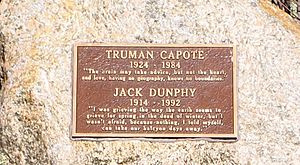
Capote died in Bel Air, Los Angeles, on August 25, 1984. The cause of death was liver disease. He died at the home of his friend Joanne Carson.
Capote was cremated. His ashes were divided between Carson and his partner, Jack Dunphy. Carson said she kept the ashes in an urn. The ashes were reportedly stolen during a Halloween party in 1988 but were found and returned. They were reportedly stolen again but recovered. Carson bought a burial spot at Westwood Village Memorial Park Cemetery in Los Angeles.
Dunphy died in 1992. In 1994, both his and Capote's ashes were scattered at Crooked Pond in Long Island. This spot was chosen because money from their estates was given to a nature group. This group used the money to buy land around the pond. A stone marker shows where their ashes were scattered. In 2016, some of Capote's ashes that Joanne Carson had were sold at an auction.
Capote also owned property in Palm Springs, a condo in Switzerland, and a main home in New York City. Capote's will created a special trust after Dunphy's death. This trust uses money from Capote's works to fund literary prizes, fellowships, and scholarships. One of these is the Truman Capote Award for Literary Criticism in Memory of Newton Arvin. It honors both Capote and his friend Newton Arvin.
Permanent Hometown Exhibit
Capote's childhood is featured in a permanent exhibit. It is at the Old Courthouse Museum in Monroeville, Alabama. The exhibit shows his life in Monroeville with his cousins. It also shows how those early years influenced his writing. The exhibit includes photos, letters, and other items. Many of these items belonged to his mother and a cousin he lived with as a child.
Truman Capote on Film
- In 1961, Capote's novel Breakfast at Tiffany's (1958) was made into a film. It starred Audrey Hepburn. Capote did not like the changes made to the story for the movie.
- His childhood memories are in the story A Christmas Memory (1956). He adapted it for TV and narrated it. It aired in 1966.
- The 1967 film In Cold Blood was based on his novel. It was filmed in the actual house and places in Kansas where the events happened.
- Capote narrated The Thanksgiving Visitor (1967). This was a follow-up to A Christmas Memory.
- The TV play was later part of a 1969 film called Trilogy.
- Capote played a main role in the movie Murder by Death (1976). He played a rich man who invited detectives to solve a murder. He was nominated for an award for this role.
- Woody Allen's film Annie Hall (1977) has a scene where someone says, "Oh, there's the winner of the Truman Capote Look-Alike Contest." The person walking by is actually Truman Capote.
- Other Voices, Other Rooms (1995) was made into a film.
- In 1995, Capote's novel The Grass Harp (1951) was made into a film. This story is partly about Capote's childhood in Alabama.
- The 1996 TV miniseries In Cold Blood was also based on his novel.
- The TV movie Truman Capote's A Christmas Memory (1997) was a remake of the 1966 TV show.
- In 2002, Capote's short story "Children on Their Birthdays" was made into a film. It was another story about a small-town Alabama childhood.
Documentaries About Capote
- With Love from Truman (1966) is a documentary. It shows a reporter interviewing Capote about In Cold Blood.
- Truman Capote: The Tiny Terror (1997) is a documentary that aired as part of the Biography series.
- The Capote Tapes (2019) uses old audio and interviews. It focuses on Capote's unfinished novel, Answered Prayers.
Portrayals of Truman Capote
In Theater
- In 1990, Robert Morse won awards for playing Capote in the one-man show Tru.
- In 1994, Bob Kingdom created a one-man show called The Truman Capote Talk Show. He played Capote looking back at his life.
In Film
- In 54 (1998), Louis Negin played Capote.
- In Isn't She Great (2000), Sam Street briefly played Capote.
- In The Audrey Hepburn Story (2000), Michael J. Burg played Capote. He also played him in The Hoax (2006).
- In Capote (2005), Capote was played by Philip Seymour Hoffman. This film is about the years Capote spent researching In Cold Blood. Hoffman won many awards for his performance, including an Oscar.
- Infamous (2006) also tells the story of Capote and In Cold Blood. It starred Toby Jones as Capote and Sandra Bullock as Harper Lee.
On Television
- In 1992, Robert Morse played Capote again in the TV version of Tru. He won an Emmy Award.
- Michael J. Burg appeared as Capote in a TV show called Life on Mars (2009).
In Literature
- The Swans of Fifth Avenue: A Novel (2016) by Melanie Benjamin tells the story of Capote's friendships with wealthy New York women. It also covers what happened after he published "La Côte Basque 1965."
Truman Capote's Works
| Year | Title | Notes |
|---|---|---|
| 1945 | "Miriam" | Short story |
| 1948 | Other Voices, Other Rooms | Novel |
| 1949 | A Tree of Night and Other Stories | Collection of short stories |
| 1950 | "House of Flowers" | Short story |
| 1950 | Local Color | Collection of travel essays |
| 1951 | The Grass Harp | Novel |
| 1952 | The Grass Harp | Play |
| 1953 | Beat the Devil | Original screenplay |
| Terminal Station | Screenplay (dialogue only) | |
| 1954 | House of Flowers | Broadway musical |
| 1956 | The Muses Are Heard | Nonfiction |
| 1956 | "A Christmas Memory" | Short story |
| 1958 | Breakfast at Tiffany's | Novella |
| 1959 | "Brooklyn Heights: A Personal Memoir" | Autobiographical essay |
| 1959 | Observations | Collaborative art and photography book |
| 1960 | The Innocents | Screenplay based on The Turn of the Screw |
| 1965 | In Cold Blood | "Nonfiction novel" |
| 1967 | "A Christmas Memory" | Best Screenplay Emmy Award; ABC TV movie |
| 1968 | The Thanksgiving Visitor | Short story published as a gift book |
| Laura | Television film; original screenplay | |
| 1973 | The Dogs Bark | Collection of travel articles and personal sketches |
| 1975 | "Mojave" and "La Cote Basque, 1965" | Short stories |
| 1976 | "Unspoiled Monsters" and "Kate McCloud" | Short stories |
| 1980 | Music for Chameleons | Collection of short works mixing fiction and nonfiction |
| 1983 | "One Christmas" | Short story published as a gift book |
| 1986 | Answered Prayers: The Unfinished Novel | Published after his death |
| 2006 | Summer Crossing | Novel; Published by Random House |
| 2015 | The Early Stories of Truman Capote | 14 previously unpublished stories from his teenage years. |
Images for kids
-
Capote photographed by Carl Van Vechten, 1948
See also
 In Spanish: Truman Capote para niños
In Spanish: Truman Capote para niños


